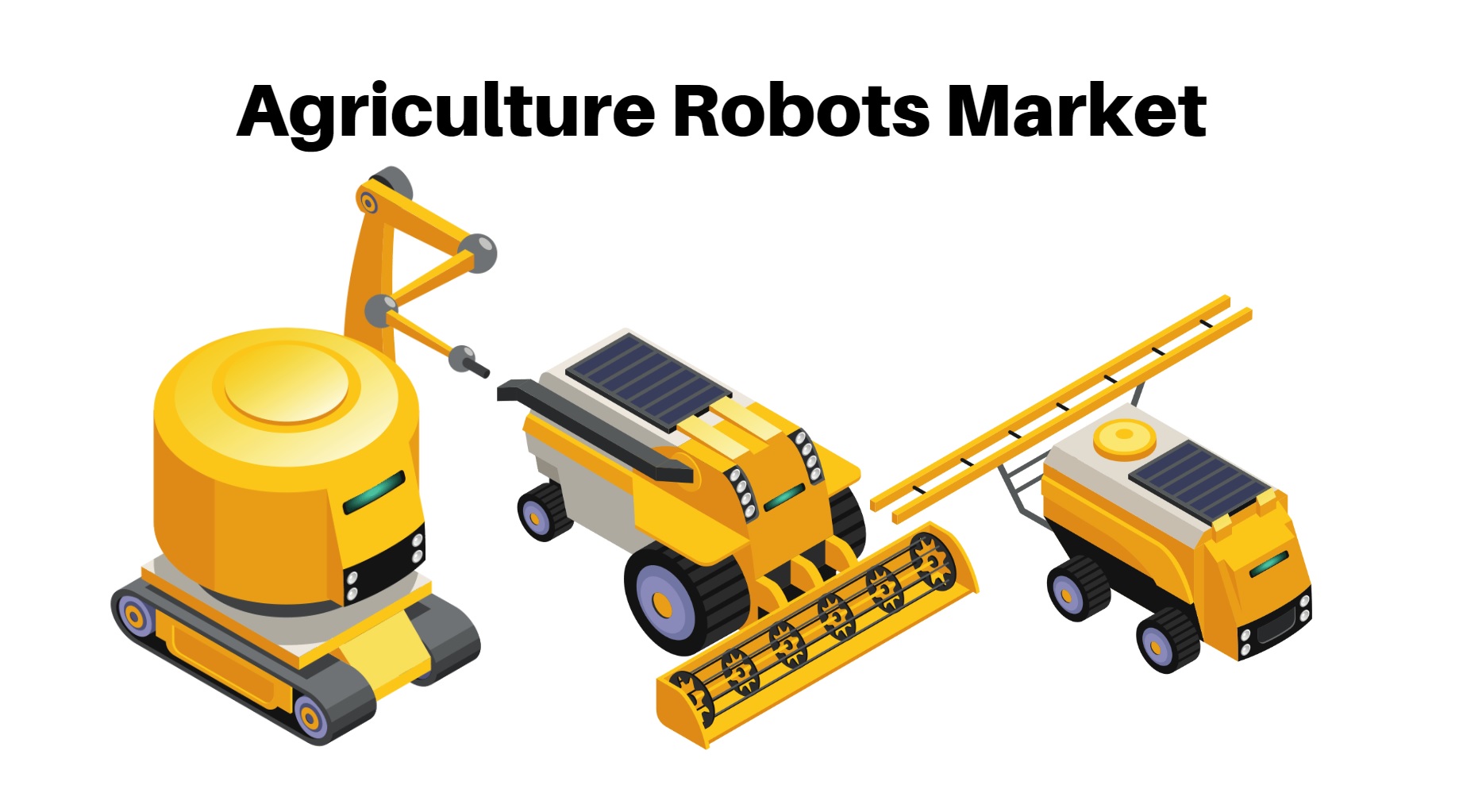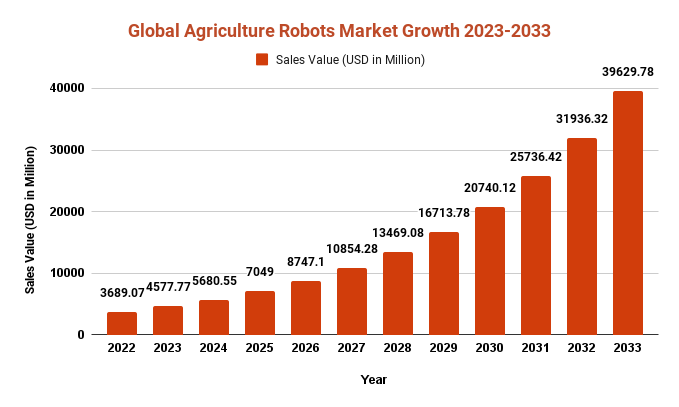Global Agriculture Robots Market Set for Rapid Growth, To Reach Around USD 39629.78 Mn by 2033

Page Contents
Market Overview
Published Via 11Press: Agriculture robots are machines designed to perform agricultural tasks such as crop monitoring, planting, watering and harvesting. Agriculture robots Market come equipped with various sensors, cameras and other technologies which collect data so farmers can make informed decisions based on it.
The Agriculture Robots Market size is expected to reach USD 39629.78 Mn by 2033, up from its current value of USD 3689.07 Mn in 2022, growing at an annual compound growth rate (CAGR) of 24.09% from 2023-2033.
Agriculture robots come in many varieties. Autonomous tractors are self-driving vehicles that can plant, cultivate and harvest crops with high precision. Harvesting robots are designed to pick fruits and vegetables quickly while using machine learning algorithms for detection and elimination of weeds without harming crops. Drone unmanned aerial vehicles (UAVs) equipped with sensors and cameras monitor crop growth patterns, detect diseases on farms and identify irrigation issues. Livestock monitoring robots monitor livestock health & welfare by tracking movements while collecting data on behavior patterns.
Robots can perform tasks faster and more accurately than humans, leading to increased efficiency and productivity. Automation reduces labor costs, with robots working around the clock without taking breaks or getting tired. Sensors on robots collect data on crops and soil so farmers can make data-driven decisions about irrigation, fertilizer application, and other farming operations. Robots reduce waste by using resources more efficiently while helping farmers reduce their environmental footprint by using fewer chemicals or other hazardous substances.
Key Takeaways
- Agriculture robots are machines specifically designed to perform farming tasks such as crop monitoring, planting, watering, harvesting and more. Examples of agriculture robots include autonomous tractors, harvesting robots, weed control robots, drones and livestock monitoring robots.
- The Agriculture Robots Market expected to reach USD 3689.07 Million in 2022.
- Forecasted compound annual growth rates between 2023 and 2033 is 24.09%.
- By 2033, the Agriculture Robots Market is projected to reach USD 39629.78 Million.
- Benefits of agriculture robots include increased efficiency & productivity; cost savings; better data collection; improved sustainability. Agriculture robots have the potential to revolutionize farming by making it more efficient & productive.

Request For Sample Report Here: https://marketresearch.biz/report/agriculture-robots-market/request-sample/
Regional Snapshot
- North America: North America is a leader in the adoption of agriculture robots, particularly in the United States. There is an emphasis on precision agriculture and using advanced technologies to boost crop yields and cut costs. North American regions are seeing more interest in using drones for crop monitoring as well as autonomous tractors for planting and harvesting duties.
- Europe: Europe has become a major market for agriculture robots. Countries such as the Netherlands, Germany and France were early adopters of precision agriculture techniques and have invested heavily in agriculture robots. These robots are being used for crop monitoring, planting and weed control purposes across this region.
- Asia Pacific: The Asia Pacific region is quickly adopting agriculture robots due to rising food demand and the need to boost crop yields to feed an ever-increasing population. Countries such as China, Japan, and Australia have led this adoption of agriculture robots within this region. Drones for crop monitoring and spraying applications as well as autonomous tractors for planting and harvesting operations are becoming more commonplace here.
- Latin America: Agriculture robots have yet to make a significant impact in Latin America. Brazil, Argentina and Mexico are the main markets for these machines; drones for crop monitoring and spraying as well as autonomous tractors for planting and harvesting are becoming increasingly popular throughout this region.
Inquire Here & Query for report: https://marketresearch.biz/report/agriculture-robots-market/#inquiry
Drivers
- Labor Shortages: The agriculture sector is facing a shortage of labor, particularly in developed countries. Agriculture robots can help address this problem by automating tasks that would otherwise need manual labor.
- Increased Demand for Food: By 2050, the world's population is projected to reach 9.7 billion people worldwide, necessitating an expansion in food production. Agriculture robots can help farmers boost their crop yields and reduce food waste.
- Technology Advancements: Recent advances in robotics, artificial intelligence and sensors have made agriculture robots more reliable and efficient. This has resulted in an increase of adoption of these technologies within the agriculture industry.
- Cost Savings: Agriculture robots can reduce labor costs and boost efficiency, leading to cost-savings for farmers. This makes agriculture robots a lucrative investment for those seeking to boost their bottom lines.
- Sustainability: Agriculture robots can help reduce the environmental impact of farming by minimizing pesticide and other chemical use. This makes them an attractive option for farmers looking to reduce their carbon footprint and enhance sustainability in their operations.
Restraints
Agriculture robots can be costly to purchase and maintain, which may deter small farmers with limited resources from adopting them. Operation and upkeep of agriculture robots necessitate specialized technical skills – something lacking in many farmers who lack this expertise. Furthermore, as these machines are designed for specific tasks only, farmers may have to invest in multiple robots to complete various jobs at once, increasing the cost of ownership significantly.
Agriculture robots are subject to regulations and policies that can limit their use, particularly in densely populated areas. For instance, farmers may need permits or permission for drone usage in certain zones. Furthermore, some farmers may be unwilling to adopt new technologies if they have been farming the same way for years; this too could hinder adoption of agriculture robots and other advanced technologies. The primary barriers for adoption of agriculture robots stem from cost, technical expertise, and regulatory obstacles; however as these advantages become more widely known it's expected that adoption rates will continue to increase over time.
Opportunities
Agriculture robots can improve effectivity and decrease labor costs for farmers. This presents an probability for farmers to expand their profitability and invest in different areas of their operation. Agriculture robots can be used for precision agriculture, which involves using records to optimize farming practices. This gives an opportunity for farmers to enhance their crop yields and reduce their environmental impact. The adoption of agriculture robots is growing rapidly, which offers an opportunity for companies that manufacture and sell these machines. There is possible for new markets to emerge as the adoption of these technologies continues to grow.
Agriculture robots can help decrease the environmental influence of farming by way of reducing the use of pesticides and different harmful chemicals. This presents an probability for farmers to enhance the sustainability of their operations and appeal to shoppers who value sustainable farming practices. There is an opportunity for collaboration and partnerships between farmers, technological know-how companies, and research establishments to strengthen and check new agriculture robots and related technologies. This can help speed up the adoption of these technologies and enhance their effectiveness.
Challenges
Agriculture robots are still relatively new and still face technical limitations such as working in all weather conditions and uneven terrain. Agriculture robots generate a lot of data which may be overwhelming for farmers; hence the need for tools and software that help manage and interpret this data to make informed decisions. Furthermore, agriculture robots must be integrated with existing farming systems and practices – something which presents an additional challenge to those who have been using traditional farming methods for many years.
Agriculture robots can be expensive to purchase and maintain, which may discourage small farmers or those with limited resources from investing. Furthermore, agricultural robots pose potential safety hazards to farmers and other workers on the farm; thus, safety protocols and regulations must be put in place to guarantee these machines are used responsibly.
Market Segmentation
Global Agriculture Robots Market, by Type
- UAV
- Driverless Tractors
- Milking Robots
- Automated Harvesting Machine
- Others
Global Agriculture Robots Market, by Application
- Field Farming
- Dairy Management
- Indoor Farming
- Horticulture
- Others
Key Players
- AGCO Corporation
- Harvest Automation, Inc.
- BouMatic Robotics BV
- AgEagle Aerial Systems, Inc.
- Vision Robotics Corporation
- Naio Technology
- PrecisionHawk, Inc.
- SenseFly SA
- Agribotix LLC
- Blue River Technology, Inc
Report Scope
| Report Attribute | Details |
| Market size value in 2022 | USD 3689.07 Mn |
| Revenue forecast by 2033 | USD 39629.78 Mn |
| Growth Rate | CAGR Of 24.09% |
| Regions Covered | North America, Europe, Asia Pacific, Latin America, and Middle East & Africa, and Rest of the World |
| Historical Years | 2017-2022 |
| Base Year | 2022 |
| Estimated Year | 2023 |
| Short-Term Projection Year | 2028 |
| Long-Term Projected Year | 2033 |
Growing Demand => Request for Customization
Recent Developments
- Autonomous Tractors: Autonomous tractors are equipped with sensors, GPS, and cameras that enable them to navigate fields and perform tasks such as planting, spraying and harvesting.
- Harvesting Robots: Harvesting robots are used in the harvesting of crops such as fruits, vegetables and grains. Equipped with cameras and sensors, these machines can detect ripe produce without damaging it and pick it without further harm.
- Weeding Robots: Weeding robots are used to manually remove weeds from crops without the use of herbicides. They utilize cameras and sensors to detect weeds, then employ mechanical tools or heat to eliminate them.
- Drone-Based Crop Monitoring: Drones equipped with cameras and sensors are used to observe crops for signs of stress, disease, or nutrient deficiencies. This data can be used to optimize fertilizer and irrigation applications.
- Autonomous Seed Planting: Autonomous seed planting robots are employed to plant crops in the field using GPS and sensors for precise placement of seeds at precise intervals and depths.
- Livestock Management Robots: Livestock management robots are used to monitor the health and behavior of livestock. They are capable of detecting signs of illness or distress in animals and alerting farmers to take necessary action.
- Soil Analysis Robots: Soil analysis robots analyze soil samples for nutrients, pH and moisture content. This information can be used to optimize fertilizer and irrigation applications.
Key Questions
1. What are Agriculture Robots?
Agriculture robots are automated machines used to automate various tasks in farming, such as planting, harvesting and monitoring crops and livestock. They may be autonomous or semi-autonomous systems designed to enhance efficiency and sustainability across farming operations.
2. What are the Advantages of Agriculture Robots?
Agriculture robots offer numerous advantages, such as increased efficiency, enhanced precision and decreased labor costs. Moreover, they can promote sustainability in farming operations by reducing chemical usage and optimizing resource use.
3. What are the challenges faced by agriculture robots?
Agriculture robots face technical limitations, data management issues, integration with existing systems, cost issues and safety concerns that need to be addressed in order for them to be successfully adopted into farming practices and integrated. These obstacles must be overcome in order for agriculture robots to become an efficient part of farming practices.
4. What are some recent innovations in agriculture robots?
Recent advancements include autonomous tractors, drone-based crop monitoring, robotic harvesters and livestock monitoring robots as well as artificial intelligence being applied to improve performance and efficiency.
5. What are some potential uses for agriculture robots?
Agriculture robots offer numerous benefits, including increased efficiency, precision agriculture, new markets, enhanced sustainability and collaborations between farmers, technology companies and research institutions to develop and test new agriculture robots and related technologies.
Contact us
Contact Person: Mr. Lawrence John
Marketresearch.Biz (Powered By Prudour Pvt. Ltd.)
Tel: +1 (347) 796-4335
Send Email: [email protected]
The team behind market.us, marketresearch.biz, market.biz and more. Our purpose is to keep our customers ahead of the game with regard to the markets. They may fluctuate up or down, but we will help you to stay ahead of the curve in these market fluctuations. Our consistent growth and ability to deliver in-depth analyses and market insight has engaged genuine market players. They have faith in us to offer the data and information they require to make balanced and decisive marketing decisions.



